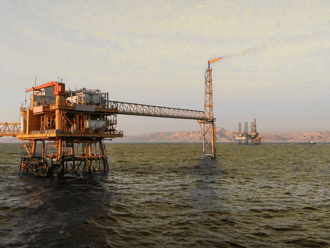July 24, 2025
Building Smarter: How Digital Twins Reduce Risk and Cost in LNG Projects

Building Smarter from the Ground Up
Imagine constructing a new LNG facility in a remote, hard-to-access region—hundreds of miles from the nearest support office. The local team is lean. Travel is expensive. Every task must be executed with precision, and every operator must work efficiently. In such environments, information delays and inefficient handovers aren’t just frustrating—they’re costly.
To reduce risk, improve safety, and ensure uptime, operators increasingly need real-time visibility into asset status and construction progress, even from afar. That’s why LNG companies are turning to a digital-first approach—with operational digital twins at the heart of facility design and construction.
In this blog, we explore how a performance-based digital twin strategy can deliver measurable value from day one of a greenfield project—streamlining collaboration between operators and EPC contractors and setting the foundation for smarter, safer operations long after startup.
Construction Challenges: Operators and EPCs Face Persistent Gaps
Before diving into solutions, it’s important to recap some of the persistent challenges that surface during LNG construction projects:
- Costly rework due to poor design coordination
- Limited or delayed access to key data
- Safety alignment issues between operators and contractors
- Quality disputes over materials and workmanship
- Scope changes and budget overruns
- Resource bottlenecks and procurement delays
In fact, studies show that up to 30% of project data is lost during handover—a gap that leads to inefficiencies, rework, and slower ramp-up to steady-state operations.
Enter the Operational Digital Twin: A New Standard for LNG Projects
By embedding a digital twin early in the project lifecycle, LNG developers can “build digitally first,” integrating design, data, and decisions into a shared digital environment. This unlocks new capabilities—from real-time construction tracking to simulation-based training and remote collaboration.
Here’s how a digital-first strategy transforms traditional challenges into competitive advantages:
Facility Design
Design with the future in mind—digitally and operationally
Digital twins enable engineering teams to validate and optimise design based on operational data, not just design intent. By embedding analytics, performance metrics, and automation capabilities into the design phase, future OPEX and emissions can be reduced before the first foundation is poured.
Top Benefits:
- Digital red thread from FEED to operations
- Analytics-driven design to minimise instrumentation and optimise layout
- Long-term operational efficiency through embedded simulation and monitoring tools
Data Access
Create a central data environment accessible by all stakeholders
A cloud-based digital twin acts as a single source of truth, allowing EPCs and vendors to contribute models, documents, and structured data in real time. Tag hierarchies, asset metadata, and document relationships can be validated and updated long before handover.
Top Benefits:
- Remote visibility into construction status and site safety
- Faster, cheaper data contextualisation
- Consistent and validated data flows across all project phases
Safety & Simulation
Improve safety with AI-enhanced simulation and virtual validation
Digital twins bring simulation capabilities that allow for scenario testing, construction sequencing, and startup rehearsals. AI models can identify potential risks, while 3D environments offer safe, remote training and planning.
Top Benefits:
- “What-if” scenario testing for safer planning
- Logic testing and virtual commissioning
- Emissions modelling for regulatory readiness
Cost & Remote Work
Enable remote teams and reduce cost through virtual tools
Through digital twins, roughly 15% of the on-site workforce can work remotely, lowering costs and risk. Engineers can take measurements, approve work orders, and visualise as-built conditions—all without setting foot on site.
Top Benefits:
- Fewer site visits and faster timelines
- Digital onboarding and role-based training
- Real-time access to site conditions, even before startup
Resource Allocation
Align project teams in a shared, real-time environment
Project teams—from field supervisors to remote planners—can coordinate construction activities in a common digital interface. This reduces delays, overlaps, and resource misallocations while improving decision-making.
Top Benefits:
- Improved visibility into resource use and bottlenecks
- Streamlined collaboration between vendors, contractors, and operators
- Centralised planning for maximum efficiency
Quality Control & Handover
AI-driven quality assurance with digital traceability
A mature twin architecture supports advanced QA/QC processes, backed by AI and machine learning. Digital workflows reduce manual errors, while automated data pipelines ensure that handover isn’t an afterthought—it’s already complete.
Top Benefits:
- Move from reactive to predictive maintenance
- Built-in QA/QC workflows with traceable history
- More accurate data, less rework
A Smarter Way to Build—and Operate
Digital-first doesn’t end with construction. It lays the groundwork for operational excellence. With a digital twin in place from the start, teams can monitor changes in scope, identify construction delays early, and ensure all systems are ready for autonomous operations from day one.
And when performance optimisation, emissions reporting, and predictive maintenance become part of daily operations—not afterthoughts—the result is a facility that’s safer, more efficient, and future-ready.
Learn More
Kongsberg Digital helps LNG developers unlock the full potential of digital-first capital projects. With our Industrial Work Surface and digital twin solutions, you gain an integrated platform for smarter planning, seamless collaboration, and long-term asset value. Explore how our digital twin technology is transforming LNG projects from design through operations.
Author

Kongsberg Digital
Kongsberg Digital is a provider of next-generation software and digital solutions to customers within oil and gas, chemicals and offshore wind. Its Industrial Work Surface, powered by the Kognitwin® platform, is redefining how industries work with data, insight and decision-making.
Related news

14 November 2025
Industrial intelligence: Connecting the physical and digital for the future of work

28 October 2025
SiteCom: 20 years of development, built for what’s next

24 October 2025
From isolated systems to connected workers

20 October 2025
Kongsberg Digital at ADIPEC 2025: Unveiling the Next Era of Energy Innovation